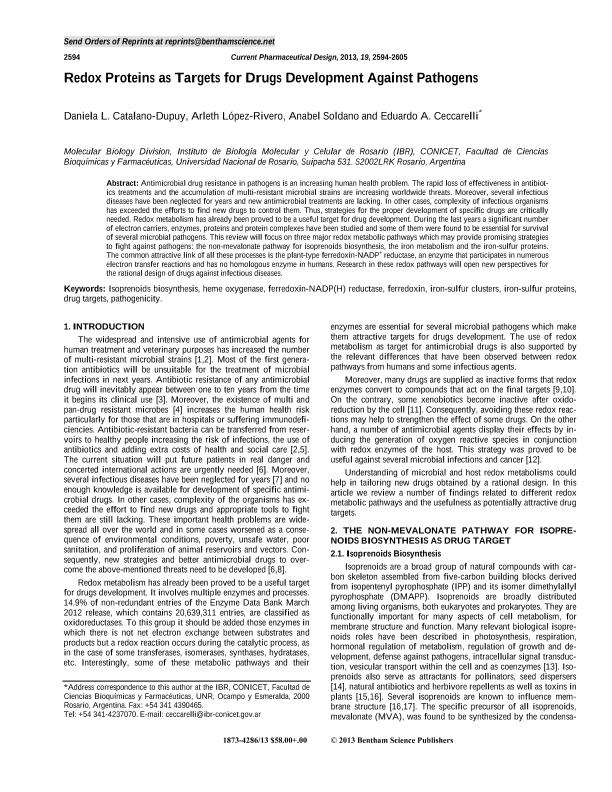Artículo
Redox Proteins as Targets for Drugs Development against Pathogens
Catalano Dupuy, Daniela Luján ; Lopez Rivero, Arleth Susana
; Lopez Rivero, Arleth Susana ; Soldano, Anabel
; Soldano, Anabel ; Ceccarelli, Eduardo Augusto
; Ceccarelli, Eduardo Augusto
 ; Lopez Rivero, Arleth Susana
; Lopez Rivero, Arleth Susana ; Soldano, Anabel
; Soldano, Anabel ; Ceccarelli, Eduardo Augusto
; Ceccarelli, Eduardo Augusto
Fecha de publicación:
01/2013
Editorial:
Bentham Science Publishers
Revista:
Current Pharmaceutical Design.
ISSN:
1381-6128
Idioma:
Inglés
Tipo de recurso:
Artículo publicado
Clasificación temática:
Resumen
Antimicrobial drug resistance in pathogens is an increasing human health problem. The rapid loss of effectiveness in antibiotics treatments and the accumulation of multi-resistant microbial strains are increasing worldwide threats. Moreover, several infectious diseases have been neglected for years and new antimicrobial treatments are lacking. In other cases, complexity of infectious organisms has exceeded the efforts to find new drugs to control them. Thus, strategies for the proper development of specific drugs are critically needed. Redox metabolism has already been proved to be a useful target for drug development. During the last years a significant number of electron carriers, enzymes, proteins and protein complexes have been studied and some of them were found to be essential for survival of several microbial pathogens. This review will focus on three major redox metabolic pathways which may provide promising strategies to fight against pathogens: the non-mevalonate pathway for isoprenoids biosynthesis, the iron metabolism and the iron-sulfur proteins. The common attractive link of all these processes is the plant-type ferredoxin-NADP+ reductase, an enzyme that participates in numerous electron transfer reactions and has no homologous enzyme in humans. Research in these redox pathways will open new perspectives for the rational design of drugs against infectious diseases.
Palabras clave:
Reacciones Redox
,
Antibióticos
,
Ferredoxina-Nadp+ Reductasa
Archivos asociados
Licencia
Identificadores
Colecciones
Articulos(IBR)
Articulos de INST.DE BIOLOGIA MOLECULAR Y CELULAR DE ROSARIO
Articulos de INST.DE BIOLOGIA MOLECULAR Y CELULAR DE ROSARIO
Citación
Catalano Dupuy, Daniela Luján; Lopez Rivero, Arleth Susana; Soldano, Anabel; Ceccarelli, Eduardo Augusto; Redox Proteins as Targets for Drugs Development against Pathogens; Bentham Science Publishers; Current Pharmaceutical Design.; 19; 14; 1-2013; 2594-2605
Compartir
Altmétricas



